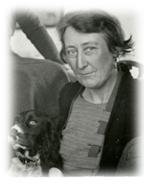Marjory Stephenson facts for kids
Quick facts for kids
Marjory Stephenson
|
|
|---|---|
 |
|
| Born | 24 January 1885 Burwell, Cambridgeshire, England
|
| Died | 12 December 1948 (aged 63) Cambridge, England
|
| Alma mater | Newnham College, Cambridge |
| Known for | Bacterial Metabolism (1930) |
| Scientific career | |
| Fields | Biochemistry, microbiology |
| Institutions | University College London University of Cambridge |
Marjory Stephenson was an important British scientist. She studied biochemistry, which is the chemistry of living things. In 1945, she made history. She became one of the first two women ever chosen to be a Fellow of the Royal Society. This is a very respected group of scientists in the UK. The other woman chosen at the same time was Kathleen Lonsdale.
Marjory Stephenson wrote a famous book called Bacterial Metabolism in 1930. This book was updated three times. It became a key guide for many generations of scientists who studied tiny living things called microbes. She also helped start the Society for General Microbiology. She later became its second president. To honor her, the Society created the Marjory Stephenson Prize Lecture. This is a big award given to top scientists in microbiology every two years.
Contents
Early Life and Learning
Marjory grew up in Burwell. This is a village in Cambridgeshire, England. Her father, Robert, was a farmer and owned a cement company. He was also an important person in the local community.
Marjory was the youngest child in her family. She became interested in science because of her governess, Anna Jane Botwright. A governess is a private teacher who teaches children at home. Marjory later went to the Berkhamsted School for Girls.
In 1903, she went to Newnham College, Cambridge. This college was part of Cambridge University. At that time, women were not allowed in all of Cambridge University's science labs. So, Newnham College had its own chemistry lab for women. Marjory studied natural sciences. She took classes in chemistry, physiology, and zoology.
Starting Her Career and War Service
After college, Marjory first planned to study medicine. But she didn't have enough money. So, she became a teacher of domestic science. This is also known as home economics. She taught at colleges in Gloucester and London. She didn't find this work very exciting.
Luckily, a scientist named Robert Plimmer invited her to work in his lab. This was at University College London. Here, she researched how the body uses fats. She also taught about nutrition. In 1913, she received a special research grant. But her work was stopped by World War I.
During the war, Marjory joined the British Red Cross Society. She managed hospital kitchens in France. Later, she became a leader for a group of volunteer nurses in Greece. She was recognized for her brave service. In 1918, she was given the MBE award. She also received the ARRC award. Because of her experiences in the war, she became a pacifist. This means she believed that all war was wrong.
Research at Cambridge University
After the war, Marjory went back to Cambridge. She did research and taught in the biochemistry department. This department was a leading place for modern biochemical studies. Here, Marjory began to study bacteria and how they work.
At first, Marjory's research was paid for by special grants. She finally became a university lecturer in biochemistry in 1943. She also became a fellow at Newnham College, her old college. In 1936, the university gave her a Doctorate of Science degree for her research.
Marjory Stephenson's main research was about how bacteria get their energy. This is called bacterial metabolism. With other scientists, she found ways to take out enzymes from bacteria. Enzymes are special proteins that help chemical reactions happen. In 1928, she was the first to get a bacterial enzyme out of a cell. This was a big step in science.
She also showed that some enzymes only appear when bacteria are grown with certain chemicals. This helped scientists understand how bacteria can adapt. She wrote more than twenty scientific papers. But she is best known for her book, Bacterial Metabolism. It was a very important book for many years.
Royal Society and Later Life
For a long time, women were not allowed to be Fellows of the Royal Society. In 1902, Hertha Ayrton was the first woman suggested for this honor. But she was rejected. The rules changed over time. Finally, in 1943, the Royal Society considered accepting women.
Marjory Stephenson was nominated. After a vote, she was elected in 1945. She and Kathleen Lonsdale were the first two women to become Fellows. During World War II, Marjory also worked on a committee that studied toxins.
Marjory helped start the Society for General Microbiology. She was asked to be its first president but said no. She was later elected as its second president in 1947. After the war, a new lab was built at Cambridge. It was sometimes called the "Bug Hut." Marjory moved there in 1947. She also helped improve how microbial biochemistry was taught at Cambridge.
In 1947, the university finally gave her a permanent position. She became the first Reader in Chemical Microbiology. Marjory Stephenson died of cancer on December 12, 1948. She was 63 years old.
People who knew her said that she created her own field in science. Her life was her work and her friends. She also enjoyed gardening and traveling. She visited the United States and the Soviet Union in the 1930s.
Legacy and Honours
- She received the Member of the Most Excellent Order of the British Empire (MBE) award.
- She also received the Associate Royal Red Cross (ARRC) award for her service in World War I.
- The Marjory Stephenson Prize Lecture was created in her honor in 1953. This is a major award in microbiology.
Images for kids
See also
 In Spanish: Marjory Stephenson para niños
In Spanish: Marjory Stephenson para niños


